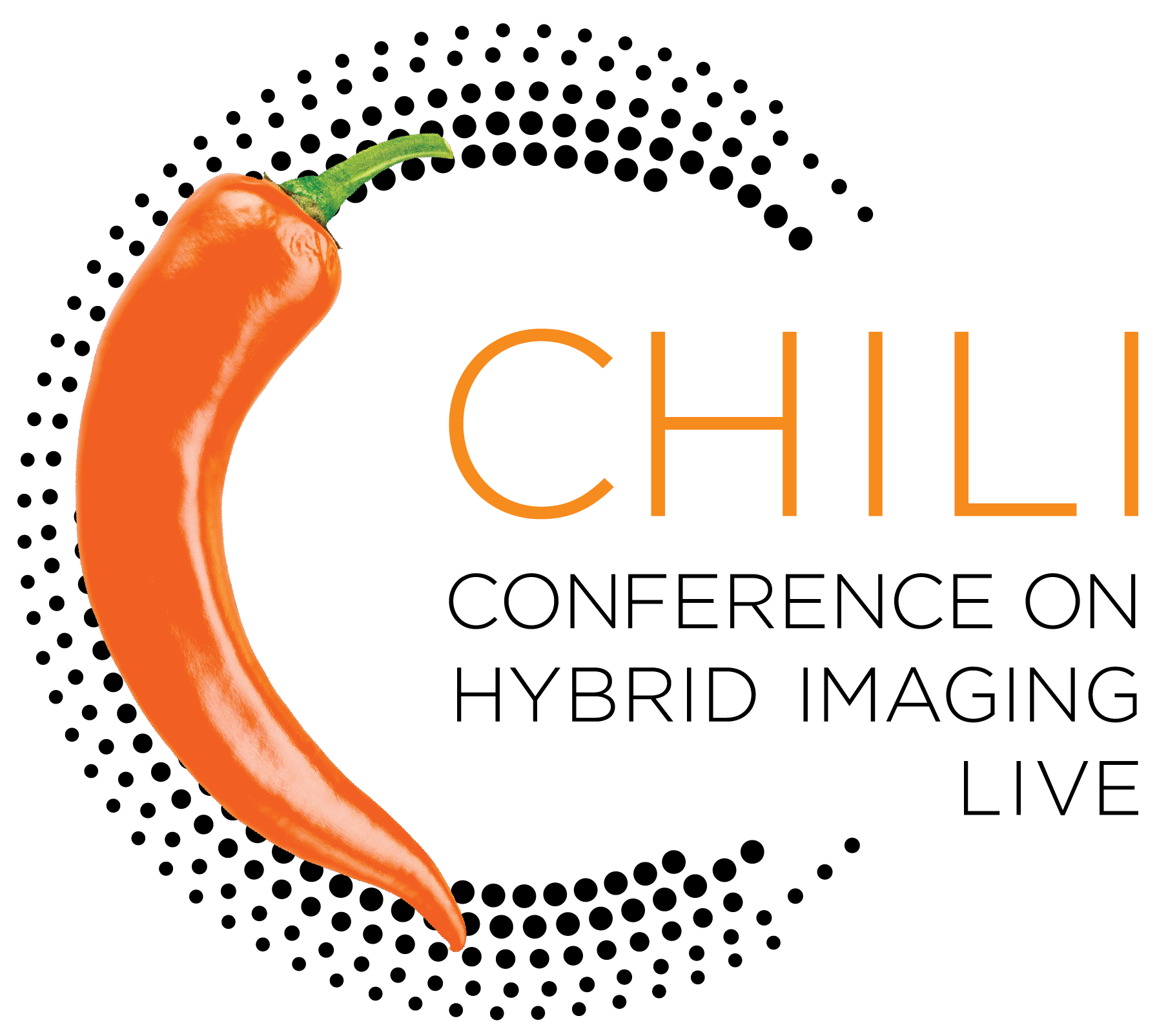CHILI questions answered by the faculty
We received so many interesting questions during the live broadcast of CHILI that our faculty did not manage to answer all of them during the dedicated discussions. This is why our expert faculty took the time to go through all of the questions from the chat and answer the most relevant/most frequent ones.
Use the menu below to jump to the session that you are interested in. Click on the questions, to open the answers.
If you have more questions or feedback, feel free to contact us anytime.

Session 1
Session 2
Session 3
Session 4
Thomas Beyer: Hybrid imaging – An introduction

Prof. Beyer, do you have any suggestions in order to reduce photon starvation artefacts in CT when scannig patients with the arms located side by side?
Thomas Beyer: First, it is recommended (see EANM GL by Boellaard et al) to scan PET/CT patients with their arms up. The techs should pre-inform the patients about the expected improvements in diagnostic quality of the scan. In case the arms cannot be moved above the head, ultra-low dose CT should be avoided; you could work with higher dose levels and ensure that alt. means of dose reduction (tube current modulation etc.) are turned on.
I don't understand how PET-CT is non-invasive if there is the injection of a radioactive element?
Thomas Beyer: Feel free to call it minimally invasive. The same would apply for CT nd MRI if IV contrast agents are being used. It is, however, well accepted to refer to PET/CT (and related hybrid imaging methods) as “non-invasive”. This is a reference to a physical action and has nothing to do with “radioactivity”.
Would it be too much radiation for the patient to go through a number of hybrid imaging exams?
Thomas Beyer: There is not too much radiation, if diagnostically indicated. Individual dose levels are monitored and regulated by national guidelines. Multiple scans, if diagnostically indicated, are covered as well.
How do you see the role of PET/MR in oncology ?
Thomas Beyer: In short, a great research tool. The search is still on for the clinical key applications in oncology, with a tendency towards prostate cancer. Feel free to scout for the respective literature, such as: https://www.ncbi.nlm.nih.gov/pubmed/26742709 .
How far should two PET imaging centres be ideally in a dense city?
Thomas Beyer: PET imaging centres should fulfill a purpose: to help patients in need. If there are many patients to be diagnosed with PET then perhaps multiple PET scanners are needed (depending on the throughput regulations and other factors). Whether or not these systems are situated in one or multiple places depends on the owners, the accessibility and other factors. No a priori guidance.
Can we say that we use PET/MR when either we have concerns about radiation dose or we need Q information. Otherwise, is PET/CT the gold standard modality?
What are the limitations of PET/MR?
Thomas Beyer: Price. Complexity. Lack of routine key applications.
Which is best: SUV max or SUV mean and why?
Thomas Beyer: Please consult: https://www.ncbi.nlm.nih.gov/pubmed/25452219. In short, SUVmax is prone to noise effects. SUVmean disregards heterogeneities. SUVpeak is to be preferred. Whatever you do, stick to one value when reporting follow-up.
Barbara Malene Fischer: 18F-FDG PET/CT in oncology – basic considerations

How do we evaluate positive focus in the bone that shows no morphological changes in patients with malignant tumor history?
Barbara Malene Fischer: It depends very much on the location and patient history, but also on the avidity of the hot-spot. If a patient had a solitary intensely FDG-avid focus in a vertebral body (centrally) or in a pelvic bone (e.g. right or left pubic bone) I would most likely report it as suspicious for malignancy, even if there was no morphological changes on CT. However, if a patient had 2-3 foci on adjacent ribs I would be les worried.
How to identify signs of malignant lymph nodes?
Barbara Malene Fischer: You need to consider FDG-avidity, pattern of uptake, size, location (together with the location of the primary tumour).
If you want to start new a cancer center, which machine installation is better PET/CT or PET/MR?
Barbara Malene Fischer: I would start with PET/CT.
In the case of a patient with suspected lung cancer, do you perform PET/CT with iv contrast or CT with iv contrast and PET/CT without iv contrast?
Barbara Malene Fischer: I personally prefer CT with contrast, but many institutions – mainly due to financial and/or logistical reasons – do a low-dose CT without contrast.
How useful is PET/CT in the joint staging and radiotherapy treatment planning of lung cancer patients?
Barbara Malene Fischer: Very useful if possible. However RT needs to start relatively shortly (approx. <4 weeks) after staging and the PET/CT should be done in treatment position.
Dr. Fischer, why do you say it's better to asses lung node malignancy on PET/CT visually rather than quantitatively? And how should it be done?
Barbara Malene Fischer: You can’t discriminate between a benign and malignant nodule based on the SUV alone, but need to consider many other factors as well.
What other agents can be used to image cancer beside FDG?
Barbara Malene Fischer: That will depend on the type of cancer you are looking for.
How do you reduce the bowel activity?
Barbara Malene Fischer: We don’t on a standard FDG PET/CT.
How can you differentiate the coexistence of malignancy and infectious or inflammatory lesions like sarcoidosis in the mediastinal lymph nodes with 18 FDG?
Barbara Malene Fischer: You can’t discriminate between malignant lymph nodes and e.g. sarcoidosis in the mediastinum based on the SUV alone. However, the pattern of uptake will often differ (e.g. lambda- sign in sarcoidosis) – but if the patient is not known with sarcoidosis it will most often be necessary with an EBUS to rule out e.g. lymphoma.
When is the optimal time to perform PET/CT post chemotherapy?
Barbara Malene Fischer: The recommendation is > 2 weeks after chemotherapy. The truth is we don’t really know.
Do you use and recommend iv contrast enhanced PET/CT?
Do you agree that delayed images are good negative if the SUV did not increase in the delayed images when we are looking for malignancy or recurrence?
Barbara Malene Fischer: This is suggested in the literature. However, the clinical benefit compared to the more complex logistics is not convincing.
What`s your experience with NaF-PET, FDG-PET and diagnostic CT of cancer mammae and metas? The best and shortest way for patient (and doctor)?
Barbara Malene Fischer: I would start with FDG-PET/CT.
José Vercher-Conejero: Pitfalls in 18F-FDG PET/CT

How do we evaluate a positive FDG nodule in a non-corrected image that is negative on the corrected one?
José Vercher-Conejero: First, you should evaluate both images (AC and non-AC) side by side and try to discart possible artifacts due to the CT portion (though mainly, these artifacts generate the opposite, uptake on the AC-PET images and no abnormal uptake on the non-AC-PET. If this artifact is due to respiratory motion, repeating the BED on that anatomical region or using a respiratory gating mechanism could solve the problem.
Are contralateral mediastinal slightly positive lymphe nodes (SUV max till 3 ) considered malignant too?
José Vercher-Conejero: No. SUVmax should not only has to be the only information to take into account when reporting a PET/CT scan…you also have to evaluate lymph node uptake distribution (bilaterality), location of the lung nodule/mass, clinical history, etc. Some reactive (immflamatory) lymph nodes may have a higher uptake than 3 and be benign.
How difficult is it to diagnose a bladder cancer pathology with PET/CT, given the release of the drug in the bladder cavity? What will help in this matter?
José Vercher-Conejero: Evaluation of FDG metabolism of bladder lesions can be difficult mainly because the urinary excretion of FDG interferes with visualization of the primary bladder tumor. However, it’s important to keep in mind that the patient should void the bladder just before the PET adcquisition. Besides that, placing a urinary catheter on the patient or delayed pelvic images after diuretic administration and oral hydration may help.
How can we differentiate reactive changes from residual neoplasia in post-operative PET/CT?
José Vercher-Conejero: Sometimes, reactive (immflamatory) changes may exhibit high FDG uptake and therefore it might be difficult to differenciate it from residual neoplasia. However, there are many different approaches you may do in order to help you distinguish reactive vs. malignancy such as dual time phase/acquisition, diffuse vs. focal uptake…and obviously clinical history (time from surgery… it’s recommended to wait at least a month after the surgical procedure to perform the examination). If with these, you’re not able to discriminate it, then a clinical context and a re-scaning after a few weeks or a month could be suggested.
Can you please list the most tumors which are not FDG avid?
José Vercher-Conejero: Some malignant processes might show low FDG uptake such as renal cell carcinoma, some lung tumors (carcinoid, lepidic ADK), hepatocellular carcinoma, mucinous neoplasms, indolent lymphomas, well-differenciate neuroendocrine tumors and well-differenciate thyroid tumors or some breast cancer histology (lobular).
What is the difference between the cancer uptake and the infection uptake when we use FDG?
José Vercher-Conejero: Sometimes it can be difficult to differentiate it if we only rely on FDG uptake. Anatomical infomation should be evaluated along with the lesion uptake to be more specific.
Dr. Vercher, could you please go in more detail over the liver artifact from your lecture?
José Vercher-Conejero: On a normal basis, the CT acquisition takes few second to be performed and the BED from the PET usually takes around 2-3 min depending on the PET/CT equipment, so during this PET acquisition the patient has an respiratoy motion.
How do you differentiate pseudoprogressionon from progression when the patient is on check point inhibitor therapy?
José Vercher-Conejero: When evaluating treatment response with PET/CT in a patient who’s receiving this type of drug, it’s important to keep in mind that if there are doubts of pseudoprogressionon vs. progression, a follow-up scan might be helpful. I recommend you to read a review a recent published paper FDG PET/CT for assessing tumour response to immunotherapy from Aide et al. (Eur J Nucl Med Mol Imaging. 2019; 46(1): 238–250).
How do we know it’s brown fat uptake if it’s very close to the lesion?
José Vercher-Conejero: If the CT portion doesn’t help much, you can repeat the BED position re-evaluating the FDG uptake and check if the fused image with the CT helps (uptake foci on a fat density tissue). Also, bilateral uptake (if present) and its distribution might help.
Can SPECT/CT replace PET/CT ?
José Vercher-Conejero: I doubt this can happen due to all the advantages from PET/CT over SPECT/CT. Other discussion topic would the the opposite, if PET/CT can replace SPECT/CT…
How difficult is it to diagnose oncologic pathology of the bladder on PET/CT? What dianostic techniques can help in this matter?
José Vercher-Conejero: I agree with you, evaluation of FDG metabolism of bladder lesions can be difficult mainly because the urinary excretion of FDG interferes with visualization of the primary bladder tumor. However, it’s important to keep in mind that the patient should void the bladder just before the PET acquisition. Besides that, placing a urinary catheter on the patient or delayed pelvic images after diuretic administration and oral hydration may help.
Myriam Wartski: PET/CT for therapy management of breast cancer patients

Can SUV suggest a difference of pathologycal type of breast carcinoma? Do Ductal carcinoma have some specificity of local SUV?
Myriam Wartski: Yes. As mentionned, ductal carcinoma have higher SUVmax than lobular carcinoma. Also, all factors of tumor aggressivity (ductal, SBR 3, high mitotic index, Triple negative phenotype, high Ki-67) are correlated with high SUV values.
In the era of FDG-PET/CT is there any place at all for NaF-PET?
Myriam Wartski: A moderate place because FDG PET/CT is generally used for visceral and bone metastasis assessment in one exam.
How much interval would you suggest between scans when evaluating metastases after treated with immune check point inhibitors?
Myriam Wartski: This depends on the clinical problem.
What is the perfect time to assess the patients after chemotherapy?
Myriam Wartski: in neoadjuvant setting, timing of response evaluation with FDG PET/CT depends on the chemotherapy regimen and is variable among studies and trials.
Dr Wartski, does it make any sense to combine FNa and FDG together?
Myriam Wartski: It is not routinely used, in fact.
Do you recommend PET/CT for the initial staging of all histological types of breast cancer?
Myriam Wartski: Yes, from stage II and above.
Can FDG PET/CT replace bone scans for the assessment of response of bone metastasis in breast cancer?
What are the histological breast cancer variants withh low FDG uptake?
Myriam Wartski: Lobular.
What is recommended in a patient with breast primary and having intensive skeletal metastatis? PET/CT or PET/MRI?
Myriam Wartski: PET/CT.
Patrick Veit-Haibach: The role of PET/CT in esophageal cancer

Prof. Veit-Haibach, can you comment on preferred imaging method for pre-operative staging? PET/CT vs EUS?
Patrick Veit-Haibach: EUS is done clinically almost always anyway. It has the much higher resolution and therefore defines the depth of invasion usually better than cross sectional imaging. Also, small peritumoral lymh nodes are usually better seen. The PET/CT is for other local lymph node metastases and distant metastases detection. Also at baseline the PET/CT defines the uptake which can then be compared after neo-adjuvant radio/chemotherapy. The delta between the FDG uptake pre and post therapy is predictive of the overall prognosis.
In case of Ca oesophagus, can we prescribe barium to swallow in a PET/CT scan?
Patrick Veit-Haibach: You can, but I do not see the use in that. Usually you would give positive oral contrast for the GI tract for the abomdinal CT part of the examination. An extra barium swallow would maybe show some ulceration of the tumour, but those tumours are usually larger anyway. And you would have captured that information with the EUS before anyway.
Prof. Veit-Haiback, do you have experience with PET/CT specifically for the subgroup of mucinous oesophageal tumours? Same avidity -> sens/spec?
Patrick Veit-Haibach: Mucinous tumours are usually gastric tumours, not purely esophageal tumours. Mucinous tumours are only FDG postive in about 50% of cases, so there is no routine use recommended in those tumour entities.
Is early detection of esophageal cancer possible with PET?
Can we use F Dopa for esophageal cancer?
Patrick Veit-Haibach: Maybe you’ll find one or the other positive esophageal tumour, but I have not seen that so far. I am not aware of a case report about that either. It is not recommended for any routine use in this disease.
Jean-Noël Talbot: Hybrid PET in inflammation and infection

Can FDG PET/CT be used in differentiating the tuberculous nodule and solitary pulmonary nodule?
Jean-Noël Talbot: Not on basis of the standard image itself at 60 min, but of course the clinical context will help. Some authors advised to compare with a delayed acquisition (120 min or so), an increase of SUV favouring malignancy but the enhancement of specificity is not obvious and this procedure is difficult in real life if you plan to perform at least 16 PET/CTs per day.
What is the role of PET/CT in sarcoidosis?
Jean-Noël Talbot: Major with FDG. To detect myocardial involvement, patients being prepared with a low carbohydrate regimen, to specify disease spread and to objectivate response to treatment. It is an official indication in the Core Summary of Product Characteristics of FDG in EU.
What is the role of FDG PET/CT in skull base osteomyelitis as compared with contrast enhanced MRI?
Jean-Noël Talbot: I am not aware of a published series for this indication. FDG has a reduced performance in the base of the skull due to its uptake by brain cortex. In other segments of the spine, FDG is sensitive to detect osteomyelitis and also to check the response for treatment and to determine whether it may be stopped.
Mildly active LNs in a treated patient of Lymphoma. How can we differentiate inflammatory from relapsing disease?
Jean-Noël Talbot: It is very difficult if a baseline FDG PET/CT has not been performed for staging. This is highly recommended in France, even though some authors in Germany have questioned its indication.
Do you recommend the use of FDG PET/CT in joint prosthesis infection?
Jean-Noël Talbot: This indication is listed in the FDG SmPC of EMA only for the hip, not for the knee or the shoulder. If negative, the NPV is good enough to rule out an active infection unless there are major arguments favouring this diagnosis. If positive, a differential diagnosis with pure inflammation should be made, considering the location of the foci (references in my presentation) and the presence of foci in the soft tissue. In difficult cases, labelled leucocytes scintigraphy cannot be avoided. A pure tracer of infection is currently lacking for PET but researches are underway.
When does PET/CT play a role in vessels prostheses? Is a linear uptake along the protheses considered a rejection or infection?
Jean-Noël Talbot: FDG can play a role in the diagnosis of vascular and cardiac valves infection. It is part of the list of indications. Elements of differential diagnosis have been published and references are given in my presentation even though I had no time to comment on that. The differential diagnosis between infection of a vascular prosthesis and vasculitis is usually easy, thanks to the CT landmarking the prosthesis and since vasculitis is usally diffuse in several vessels.
Prof. Talbot, is it better to identify the source of infection first before starting meds in PET with an unidentified source on routine imaging?
Jean-Noël Talbot: Sure! If the meds result in some incomplete response or relapse when stopped, there is a risk that the lesions would be partially stunned with a poor contrast as background.
In the case of unilateral ovary abscess and contralateral ovary cyst, could CE MR be considered for diagnosis of ovary abscesses (possibly if it was suspected in CT/US)?
Jean-Noël Talbot: I have no such data present. To the best of my knowledge it has not been published.
Recent EANM guidelines do not advise the use of FDG in Prosthetic Joint infections. Can you explain why?
Jean-Noël Talbot: This indication is listed in the FDG SmPC of EMA only for the hip, not for the knee or the shoulder. If negative, the NPV is good enough to rule out an active infection unless there are major arguments favouring this diagnosis. If positive, a differential diagnosis with pure inflammation should be made, considering the location of the foci (references in my presentation) and the presence of foci in the soft tissue. In difficult cases, labelled leucocytes scintigraphy cannot be avoided. A pure tracer of infection is currently lacking for PET but researches are underway.
Probably the writing party of he EANM guidelines was composed of NM specialists with an advanced practice. In the real world it is far easier to find a slot of FDG PET than a department of NM which performs leucocyte scintigraphy with in vitro labelling which is the reference method. So FDG PET may be the 1st line and it is more sensitive than bone SPECT.
What if the SUV max is low but on CT it is typical of malignancy. What should we report on that lesion?
Jean-Noël Talbot: In my experience this is not a frequent case, perhaps because patients with lesions typical for malignancy on a previous CECT are not all referred to PET/CT for staging or restaging. Of course it depends whether you have chosen the right tracer for PET. FDG is not sensitive for prostate cancer or well differentiated HCC or renal cancer or brain tumors or bronchoalveolar cancer or mucinous producing cancer or neuroendocrine neoplasias for which more sensitive tracers are available as FCH or PSMA or somatostatin ligands or may FAPI in future.
Helen Nadel: Hybrid imaging in paediatrics

Is PET/CT useful for the detection of micrometastases in recurrent immature teratoma in pediatric patients?
Helen Nadel: PET/CT can of course detect very small metabolically active metastases. Germ cell tumors are usually FDG avid as are their mets to include all forms. Size would not determine if metastasis were visible possibly
Prof. Nadel, we are always facing global FDG uptake in pediatric patients, is there a solution for this issue?
Helen Nadel: Global as in total body vertex to toes? The reason for this is that pediatric malignant disease can often occur distally in children, i.e. below elbows and knees. The time to add on the few bed positions can sometimes make a difference in staging. However, we do routinely decrease our time for bed postion in the head and extremities from torso. We would routinely decrease from 2 min for torso to 1 min for head and extemities without prior knowledge of disease in these areas. Recently we have had an IAEA publication that does state that in PEDIATRIC LYMPHOMA the incidence of disease that may upstage the patient is low enough to restrict to ‘eyes to thighs” imaging but I caution this is validated currently only for lymphoma. Reference : Cerci JJ, Etchebehere EC, Nadel H, Brink A, Bal CS, Rangarajan V, Pfluger T, Kagna O, Alonso O, Begum FK, Mir KB, Magboo VP, Menezes LJ, Paez D, Pascual TN. Is True Whole-Body (18)F-FDG PET/CT Required in Pediatric Lymphoma? An IAEA Multicenter Prospective Study. J Nucl Med. 2019 Aug;60(8):1087-1093. doi:
10.2967/jnumed.118.222299. Epub 2019 Jan 25. PubMed PMID: 30683766.
How do you suspect malignant changes in children in order to distinguish from inflammatory diseases at an early stage and start diagnosing in time?
Helen Nadel: FDG is of course non specific so careful correlation with history and physical as well as laboratory results is mandatory. Benign disease such as inflammation can usually be less focally avid but there is no SUV or visual cut-off. In Sarcoma for instance it would be usually an order of magnitude greater FDG avidity for osteosarcoma or Ewing sarcoma. Rhabdomyosarcoma can be less avid in some cases but all are “usually” more avid than inflammation. Ultimately, biopsy is required to confirm a tissue diagnosis.
Prof. Nadel, when do we need SPECT/CT or PET/CT in Neuroblastoma? Which technique reveals higher specificity, sensitivity, TP, FN, FP in NBL?
Helen Nadel: mIBG is still the mainstay for staging and response assessment for neuroblastoma as treatment protocols require a Curie score or SIOPEN score be given which is currently only vailidated for mIBG and not PET. 10% of all neuroblastoma patients may be mIBG negative in this instance PET with FDG or even Ga 68-DOTA or F-18 DOPA may be utilized. A newer indication for correlation with FDG PET is when there is persistent mIBG activity in patients who have no other evidence of active or progressive disease either clinically or biochemically. These patients might still have abnormal mIBG uptake that has not changed over a long time even when off therapy. The as yet not validated use for FDG PET is that if the lesions are negative on FDG while still hot on mIBG this may now have differentiated to more benign disease such as ganglioglioma or other benign neural crest tissue. Concordance on mIBG and FDG could suggest disease still has malignant potential and may require biopsy to confirm if now benign neural crest tissue that still remains only mIBG positive. Reference: Sharp SE, Shulkin BL, Gelfand MJ, Salisbury S, Furman WL. 123I-MIBG scintigraphy and 18F-FDG PET in neuroblastoma. Journal of Nuclear Medicine. 2009 Aug 1;50(8):1237-43.
Are any cardiac PET/MR done on children?
Helen Nadel: There are some centers that are starting to use this. We plan to start such a program in conjuction with cardiology and cardiac surgery here at Stanford but have not started as yet. It can be done as it is in adults with some modifications.
Prof. Nadel, Is it possible to register synthetic CT images to PET/MR to take advantage of both CT & MRI (attenuation, soft tissue contrast, ...)?
Helen Nadel: Coregistration is possible to all cross sectional imaging. It is more easily done in NM third party software programs that already allow coregistration and fused and non fused image data sets. Other software such as Osirix can also coregister most cross sectional data sets from any such modality. It can have variable results if movement and positioning can be quite different between data sets but it is much more possible and works more often tnan it did before we actually had hybrid machines and ONLY were able to use software fusion.
Can PET/MRI be used for the detection of metastatic lung lesions especially in paediatric oncology patients, despite poor morphological expression on MRI?
Helen Nadel: If the lung lesions are FDG avid, it will be seen on the scan. Some specific MRI sequences can visualze the lung with pretty good sensitivity. We use a propeller and T1g MRI sequence routinely.
Prof. Nadel, which radiopharmaceutical reveals greater specificity and sensitivity in PET-CT (FDG or GA Derivates)?
Helen Nadel: The choice of radiopharmaceutical depends on the indication for the scan. We recently had a case of unusual undifferentiated carcinoid tumor that was very avid on FDG PET and yet not as avid on Ga-68 dotatate reflecting the undifferentiated histology of the tumor. In general there is more limitation to the neuroendocrine tumor types for the Ga radiophar. in neuroendocrine tumors also depends on tumor type and histology see answer above regarding neuroblastoma.
Clemens Cyran: Monitoring immunotherapy with hybrid imaging

If the PERCIST criteria was regressive while the RECIST criteria was progressive, which one we will depend on?
Clemens Cyran: Considering that both criteria are generally used in a study setting, the criteria that are defined in the study protocol should be followed. However, as also stated in the lecture, eventually morphological and functional information contributes to superior diagnostic accuracy.
In a resource poor center without PET/PET/CT should response to therapy be done after 4 months after treatment rather than 1 month for accurate diagnosis?
Clemens Cyran: If monitoring of immunotherapy relies on conventional CT, time points for response monitoring should be carefully aligned with the oncologist and results need to be interpreted along the lines of immunotherapy criteria such as iRECIST with particular regard to uPD.
Can hybrid imaging be used in therapeutic genetic applications in the future?
Prof. Cyran, can we predict tumor progression of mutiple myeloma in palsmocytoma patients with PET parameters?
Clemens Cyran: Indeed, there are recent studies that show predictive values of FDG PET/CT in patients with MM with regard to PFS and OS.
What should be the response in therapy monitoring if most of the target lesions showing decreased metabolism with a new lesion that is suspicious of disease?
Clemens Cyran: This depends on the criteria applied for assessment. Generally, when monitoring immunotherapy the concepts of dedicated criteria with particular regard to unconfirmed/confirmed progression should be kept in mind.
Katrine Riklund: Monitoring immunotherapy with hybrid imaging

When performing a whole body bone scan on a suspected prostate patient, is it better to also perform a SPECT/CT to get a better look at the pelvis?
Katrine Riklund: In general, more inforamtion is gained with SPECT and it gives better information about the topography. On a patient level, the information on planar scint is most often accurate. As a problem solver, an added SPECT of the pelvic region is worth doing.
Does antiandrogen therapy affect PSMA expression and tracer uptake?
Katrine Riklund: Yes, antiandrogen therapy might reduce the uptake but prostate cancer is a multi-faced disease so the effect differ between patients.
Focal low grade prostatic uptake (< 3 SUV max). Could it be diagnosed as neoplasia in Ga-PSMA PET/CT?
Katrine Riklund: Yes, it could.
Has F18-PSMA Advantages over Ga68-PSMA besides halflife?
Katrine Riklund: The results so far show that F-PSMA is at least as good as Ga-PSMA with similar T/NT ratios. One added advantage is the low urinary excretion at time of scanning which makes F-PSMA superior over Ga-PSMA for evalutaion of lesions close to the bladder.
What are the causes for false negative findings in PSMA PET?
Katrine Riklund: Too small tumour burden, too low expression of PSMA.
Can PSMA uptake occur in benign bone lesions and mimic metastasis?
Katrine Riklund: It might accumulate in fractures and degenerative changes.
Which benign lesions and other tumors can PSMA express?
Katrine Riklund: NSCLC, granulomatous lesions, ganglions, often with lower intensity and the prostate cancer met lesions.
Harun Ilhan: Evidence of theranostics in neuroendocrine tumours and prostate cancer

For prostate patients with diffuse bone marrow involvement, is there an increased risk of BM toxicity? Is it alpha instead of Lu?
Harun Ilhan: High PSMA-ligand uptake in patients with severe bone marrow involvement plays a crucial role in terms of related toxicity. The relatively long distance of Lu177 in tissue can be related to higher toxicity rates. However, there is also data supporting a displacement of PSMA-ligand uptake in tumor and active bone marrow, thus sparing healthy bone marrow. Nonetheless the range of alpha-emitters (e.g. Ac225), which is just on cellular level should be related with less toxicity. Some therapy algorithms thus suggest to start PSMA-ligand therapy using Ac225 in patients with severe bone (marrow) involvement.
How would you combine PRRT and SIRT in NET with liver metastases?
Harun Ilhan: Both therapies have different targets and mechanisms. SIRT can be used to deliver high radiation doses on a capillary level while PRRT targets Somatostatin-Receptors on the tumor cell surface. As SIRT is a liver only therapy option, it should only be used in patients where tumor involvement of the liver is dominant. In case of high tumor load outside the liver (e.g. bone mets, lymph nodes / peritoneal) PRRT is the method of choice. Nonetheless there is data supporting a combination (e.g. stable metastases outside the liver and progression of liver metastases).
Dr Ilhan, in a Paraganglioma I131-MIBG and Ga68-DOTA avid tumor, which will be therapy of choice? I-131 MIBG or Lu177-PRRT?
Harun Ilhan: There is more and more data supporting that Lu-177 PRRT seems to be more effective in patients with Paraganglioma / Phäochromocytoma. However, pretherapeutic imaging using Ga-68/F-18 labeled TATE/TOC compounds and I-123 MIBG is highly important. The method of choice should depend on tumor uptake in pretherapeutic imaging.
Dr. Ilhan, do you see a future role of combined external radiotherapy and internal targeted radiotherapy for selected indications?
Harun Ilhan: Absolutely! This is something that we perform on a regular basis. A perfect scenario is for instance a mCRPC patient with severe pain in single regions (e.g. pelvic bone) and still high tumor load in other regions. In this scenario RLT combined with external beam radiation is absolutely reasonable with relatiely low toxicity and side effects. Other combinations could include patients with good response in most regions and progressive disease in single areas. These areas could be treated with local external beam radiation.
How do you feel about 18-FDG produced on the BG-75 cyclotron on a dose-by-demand basis for scanning?
Harun Ilhan: The BG-75 cyclotron could be of high value for sites with relatively low patient numbers (e.g. first installation of PET/CT or PET/MRI scanners).
What is the efficency of PET/CT in breast cancer metastases?
Harun Ilhan: As most BC metastases show more or less elevated Glucose-Metabolism, FDG-PET/CT can be used for staging and shows good sensitivity and specificity. Novel tracers, targeting for instance Estrogen-Receptors are under clinical investigastion (e.g. F18-Fluorestradiol) and can be of high value regarding patient selection for hormonal treatment options.
Irène Buvat: Machine learning in imaging: With or without hybrid imaging ?

